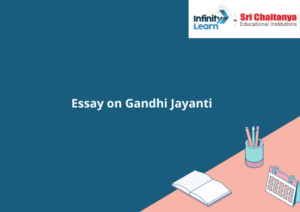We are all born with an aim in life. Some people achieve it and leave a mark, while others simply pass through life. History tends to remember only those who have been influential. Introducing one such great personality that needs no introduction, here’s a Gandhi Jayanti essay to remember and commemorate this larger-than-life personality who was known around the world for his persistence.
Gandhi Jayanti, the birth anniversary of Mohandas Karamchand Gandhi, is observed on 2nd October every year as one of the national holidays of India. This day, as well as the man whose birth it marks, stands as a symbol for peace, non-violence, and freedom from the oppressive rule of the British in India.

Popularly known as Mahatma Gandhi, he has been recognized as the ‘Father of the Nation’ for contributing to the Indian struggle for independence.
Following the path of Satyagraha, Mahatma Gandhi portrayed resistance against racism and injustice through peace. As an acknowledgment of his non-violent resistance to oppression, the UN General Assembly declared on 15th June 2007 that Gandhi Jayanti would be recognized as the International Day of Non-Violence.
A Brief Glimpse of the Mahatma’s Life
Born on 2nd October 1869 in Porbandar, Gujarat, Mohandas Karamchand Gandhi Ji studied law in England. After experiencing racism firsthand in South Africa, where he worked for an Indian law firm, Gandhi began to focus on and actively portray the cause of Indians who went through the same experiences. The satyagraha movement also started when he was still in South Africa.
Upon Returning to India: In 1915, he joined the Indian National Congress and began campaigning for swaraj. Swaraj, or self-rule, was a demand made by the Indian people for independence from the British Raj. Aware of the depth of the oppression, Gandhi called for the non-cooperation movement and the boycott movement. Urging people to give up British goods led to his imprisonment from 1922-1924.
Dandi March (Salt March): Gandhi’s influence and participation in the freedom struggle grew, as did the followers of his philosophy. One of the acts that captured attention and followers was the famous Salt March, a campaign against the outrageous salt laws of the British. These laws did not allow Indians to either produce or sell salt. A heavy salt tax was also imposed on the citizens. Led by the Mahatma himself, the walk to break the salt laws lasted from 12th March to 5th April 1930.
Joined by hundreds of Indians, Gandhi marched from Sabarmati Ashram in Allahabad to the village of Dandi. Upon reaching, he took a handful of salt in his hand, thus breaking the salt laws.
The Dandi March led to the arrest of Gandhi along with almost 60,000 other Indians. However, it also resulted in the signing of the Gandhi-Irwin pact, which agreed to release the prisoners as well as allowed the collection of salt for domestic use.
Quit India Movement (1942): Another significant event in Gandhi’s civil disobedience movement was the Quit India Movement or the Bharat Chhodo Andolan. Launched by Mahatma Gandhi in 1942 at the Bombay session of the All India Congress Committee (AICC), the activist delivered a speech to mark the occasion.
He demanded that the British should end their rule in India. In the aftermath of his demand for a do-or-die situation, all members of the Indian National Congress were arrested, and massive demonstrations took place all over the country.
Mahatma Gandhi was assassinated by Nathuram Godse on 30th January 1948, as the whole nation was left in shock. Gandhi’s autobiography, My Experiments with Truth, is one of the most-read books around the world.
Satyagraha: The idea and active showcase of nonviolent resistance was the most significant part of Mahatma Gandhi’s philosophy and sociopolitical activism. To him, upholding the principles of Truth and Love was of utmost importance in bringing a change in the social system. And he employed the same principles when he became a part of the Indian freedom movement.
Although the term satyagraha is almost synonymous with non-violence, Gandhi employed it in a way that made it his own. He launched the movement after the Jallianwala Bagh Massacre in Amritsar. One way of doing that, as he believed, was not to resort to force but to mold one’s actions in such a way that it would lead to other people changing their hearts.
In other words, he was setting an example by upholding the power of truth and self-sacrifice for the greater good of his countrymen. The philosophy of non-violence or “ahimsa” was later followed by leaders such as Martin Luther King in their struggles to end social and political injustice.
Celebrations: The day of Gandhi Jayanti marks the remembrance of the Mahatma. Celebrated with enthusiasm in most parts of the country, people pay tributes to him through prayers, speeches, and the singing of devotional songs. Such events are especially popular in schools.
Raj Ghat in New Delhi, where Mahatma Gandhi was cremated, is also lavishly decorated as a part of the celebrations.



